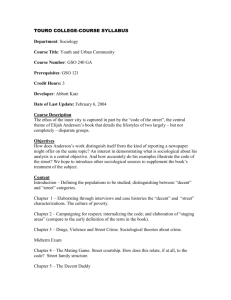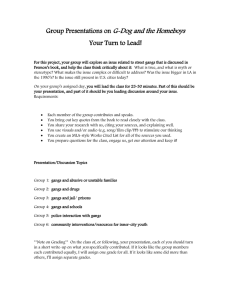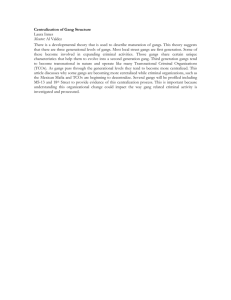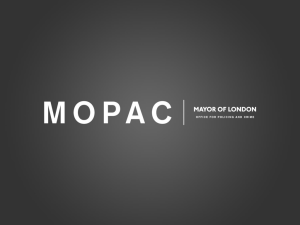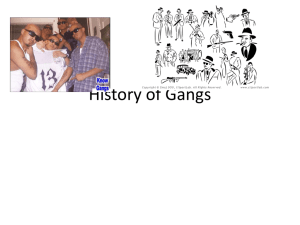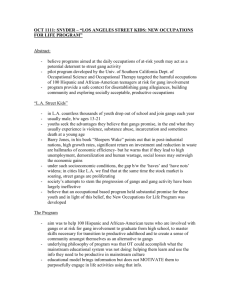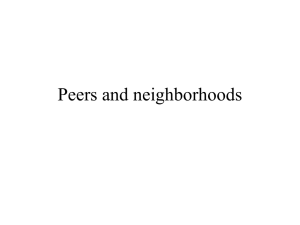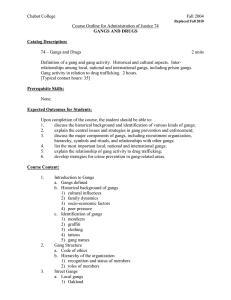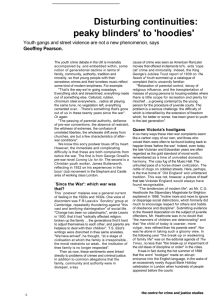Course Institutional Objectives
advertisement
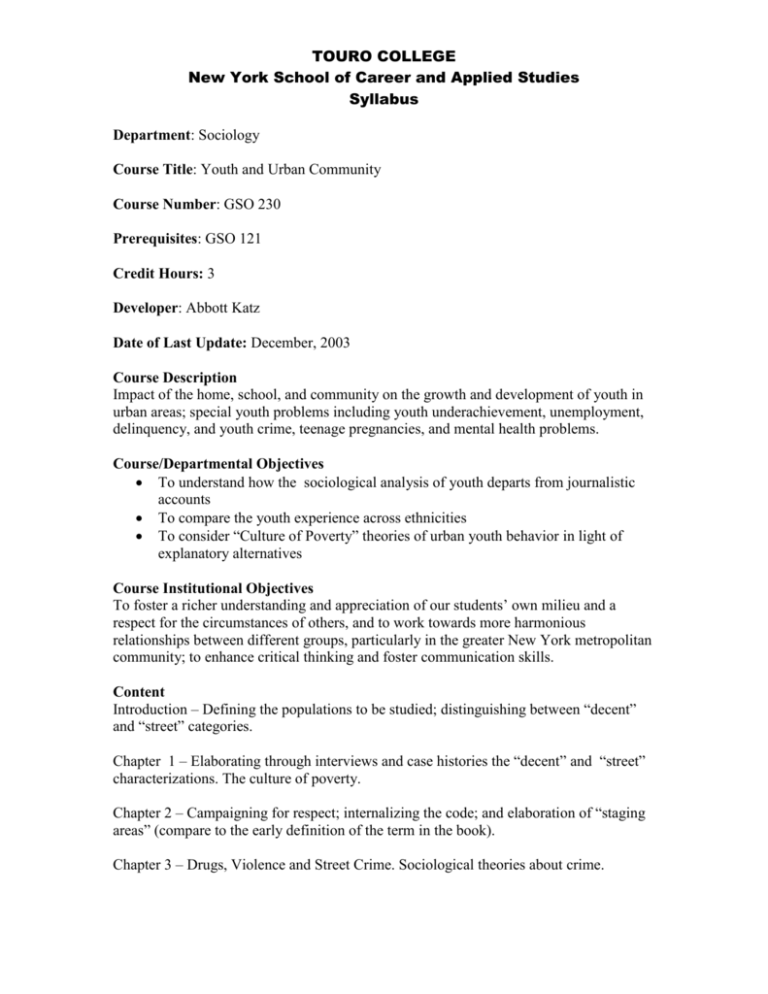
TOURO COLLEGE New York School of Career and Applied Studies Syllabus Department: Sociology Course Title: Youth and Urban Community Course Number: GSO 230 Prerequisites: GSO 121 Credit Hours: 3 Developer: Abbott Katz Date of Last Update: December, 2003 Course Description Impact of the home, school, and community on the growth and development of youth in urban areas; special youth problems including youth underachievement, unemployment, delinquency, and youth crime, teenage pregnancies, and mental health problems. Course/Departmental Objectives To understand how the sociological analysis of youth departs from journalistic accounts To compare the youth experience across ethnicities To consider “Culture of Poverty” theories of urban youth behavior in light of explanatory alternatives Course Institutional Objectives To foster a richer understanding and appreciation of our students’ own milieu and a respect for the circumstances of others, and to work towards more harmonious relationships between different groups, particularly in the greater New York metropolitan community; to enhance critical thinking and foster communication skills. Content Introduction – Defining the populations to be studied; distinguishing between “decent” and “street” categories. Chapter 1 – Elaborating through interviews and case histories the “decent” and “street” characterizations. The culture of poverty. Chapter 2 – Campaigning for respect; internalizing the code; and elaboration of “staging areas” (compare to the early definition of the term in the book). Chapter 3 – Drugs, Violence and Street Crime. Sociological theories about crime. Midterm Exam Chapter 4 – The Mating Game. Street courtship. How does this relate, if at all, to the code? Street family structure. Chapter 5 – The Decent Daddy Chapter 6 – The Black Inner-City Grandmother in Transition Chapter 7 – John Turner’s Story Conclusion – The Conversion of a Role Model: Looking for Mr. Johnson Final Exam Additional distributed readings: Asian-American Gangs (http://www.asian-nation.org/gangs.shtml) Excerpts from G. Suttles, The Social Structure of the Slum Excerpts from Martin Sanchez-Jankowsi, Islands in the Street (a multi-ethnic ethnography of gangs) Course Requirements Regular prompt attendance Midterm and final Grading Guidelines Midterm Final Class participation 40% 40% 20% Methodology Lecture and class discussion Essay exams Course Text Anderson, Elijah, Code of the Street, W.W. Norton & Company, New York and London, 1999 Bibliography Borman, Kathryn, and Barbara Schneider (eds).,The Adolescent Years : Social Influences And Educational Challenges, Chicago : NSSE : Distributed by the University of Chicago Press, 1998. Brotherton, David., Louis Barrios, Between Black And Gold : Street Politics And The Transformation Of A New York City Gang,.New York : Columbia University Press, 2003. Casella, Ronnie, “Being Down”: Challenging Violence in Urban Schools foreword by Jean Anyon, New York: Teachers College Press, 2001 Freedman, Marc. The Kindness Of Strangers : Adult Mentors, Urban Youth, And The New Voluntarism 1st Ed. San Francisco, Calif. : Jossey-Bass, 1993 Glasgow, Douglas G. The Black Underclass : Poverty, Unemployment, and Entrapment of Ghetto Youth 1st Vintage Books ed, New York: Vintage Books, 1981 Jankowski, Martín Sánchez, Islands in the street : Gangs And American Urban Society, Berkeley : University of California Press, c1991. Le. C.N.,“Asian American Gangs”, http://www.asian-nation.org/gangs.shtml Miller, Walter B. Violence By Youth Gangs And Youth Groups As A Crime Problem In Major American Cities : [Washington] : National Institute for Juvenile Justice and Delinquency Prevention, Office of Juvenile Justice and Delinquency Prevention, Law Enforcement Assistance Administration, U.S. Dept. of Justice : for sale by the Supt. of Docs., U.S. Govt. Print. Off., 1975 i.e. 1977. Min, Pyong Gap,, (ed.), The Second Generation : Ethnic Identity Among Asian Americans, Publisher Walnut Creek, Cal : AltaMira Press, 2002. Mincy, Ronald B. (ed),Nurturing young Black males : challenges to agencies, programs, and social policy, Washington, D.C. : Urban Institute Press ; Lanham, MD : Distributed by National Book Network, c1994. O’Donnell, Clifford R., (ed.), Culture, Peers, And Delinquency New York, NY : Haworth Press, 2003 Rodriguez, Joseph,.East Side Stories : Gang Life in East L.A., photographs by Joseph Rodríguez ; essay by Rubén Martínez ; interview with Luis J. Rodriquez, New York: Powerhouse Books, 2000. Sadowski, Michael (ed.), Adolescents at School : Perspectives on Youth, Identity, and Education Cambridge, MA : Harvard Education Press, 2003. Shelden, Randall G., Sharon K. Tracy, William B. Brown, Youth Gangs In American Society, 3rd ed., Belmont, CA : Thomson/Wadsworth, 2004. Suttles, Gerald D. The Social Order of the Slum,: Ethnicity and Territory in the Inner City. xxii, 1968 Series: Studies of Urban Society, University of Chicago Press Thrasher, Frederic Milton, The gang; a study of 1,313 gangs in Chicago.Abridged, and with a new introd. by James F. Short, Jr. Chicago, University of Chicago Press 1963 Vigil, James Diego, Barrio Gangs : Street Life and Identity in Southern California, forward by Robert Edgerton, 1st ed., Austin: University of Texas Press, 1988. Walker, J. C., with the assistance of Christine Hunt, Louts And Legends : Male Youth Culture In An Inner City School, Sydney ; London : Allen & Unwin, 1987. Weis, Lois and Michelle Fine, (eds.) Construction Sites : Excavating Race, Class, And Gender Among Urban Youth, New York : Teachers College Press, 2000. Wyrick, Phelan A. Vietnamese Youth Gang Involvement. [Washington, DC],: U.S. Dept. of Justice, Office of Justice Programs, Office of Juvenile Justice and Delinquency Prevention, 2000.

